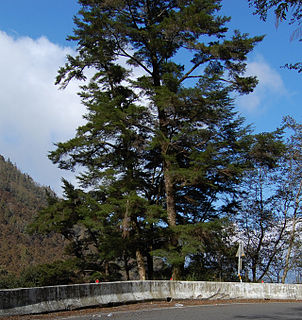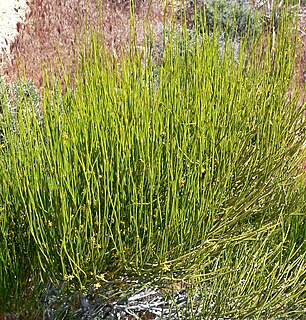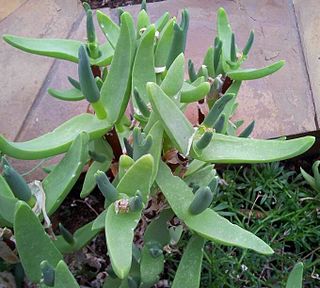
Ephedra distachya is a shrub in the family Ephedraceae that stands about 25 cm to 50 cm high. The shrub grows in many parts of the world, including southern and central Europe and western and central Asia. Its local names include somlatha.

A conifer cone is an organ on plants in the division Pinophyta (conifers) that contains the reproductive structures. The familiar woody cone is the female cone, which produces seeds. The male cone, which produces pollen, is usually herbaceous and much less conspicuous even at full maturity. The name "cone" derives from Greek konos (pinecone), which also gave name to the geometric cone. The individual plates of a cone are known as scales. The umbo of a conifer cone refers to the first year's growth of a seed scale on the cone, showing up as a protuberance at the end of the two-year-old scale.
Juniperus indica, the black juniper, is a juniper native to high-altitude climates in the Himalaya, occurring in Pakistan, India, Nepal, Bhutan and China.

Pachypodium brevicaule is a species of plant that belongs to the family Apocynaceae.

Ephedra is a genus of gymnosperm shrubs. The various species of Ephedra are widespread in many arid regions of the world, ranging across southwestern North America, southern Europe, northern Africa, southwest and central Asia, northern China and western South America. It is the only extant genus in its family, Ephedraceae, and order, Ephedrales and one of the three living members of the division Gnetophyta alongside Gnetum and Welwitschia.

Ephedra sinica is a species of Ephedra native to Mongolia, Russia, and northeastern China.

Tsuga chinensis, commonly referred to as the Taiwan or Chinese hemlock, or in Chinese as tieshan, is a coniferous tree species native to China, Taiwan, Tibet and Vietnam. The tree is quite variable and has many recognised varieties, though some are also maintained to be separate species by certain authorities. The tree was recently discovered in the mountains of northern Vietnam, making that the southernmost extension of its range.

Cephalotaxus fortunei, commonly called the Chinese plum-yew, Fortune's yew plum, simply plum yew, Chinese cowtail pine or in Chinese as san jian shan, is a coniferous shrub or small tree in the family Taxaceae. It is native to northern Burma and China, but is sometimes grown in western gardens where it has been in cultivation since 1848.

Juniperus rigida, the temple juniper, is a species of juniper, native to northern China, Mongolia, Korea, Japan, and the far southeast of Russia, occurring at altitudes of 10–2,200 m. The species is also naturalized in the United States. It is closely related to Juniperus communis and Juniperus conferta, the latter sometimes treated as a variety or subspecies of J. rigida.
Libocedrus austrocaledonica is a species of Libocedrus, endemic to New Caledonia, occurring mainly in the southern half of the island, at 750–1,400 m altitude in montane cloud forest scrub.
Libocedrus chevalieri is a species of conifer in the cypress family, Cupressaceae. It is endemic to New Caledonia, occurring in three small, isolated populations on low mountain summits at 650–1,620 m altitude in cloud forest scrub on serpentine soils. It is threatened by habitat loss.
Libocedrus yateensis is a species of Libocedrus, endemic to New Caledonia, occurring in a few small, isolated populations in low altitude riverside sites at 150–600 m altitude in rainforest scrub. It is threatened by habitat loss.

Ephedra aspera is a species of Ephedra known by the common names rough jointfir, boundary ephedra, and pitamoreal. It is native to the southwestern United States from California to Texas and parts of northern Mexico as far south as Zacatecas. It is a resident of varied woodland and scrub plant communities.

Ephedra viridis, known by the common names green Mormon tea, green ephedra, and Indian tea, is a species of Ephedra. It is indigenous to the Western United States, where it is a member of varied scrub, woodland, desert, and open habitats. It grows at 900–2,300 metres (3,000–7,500 ft) elevations.
Ephedra alata is a species of Ephedra. These plants are perennial and xerophytic gymnosperm shrubs.

Ephedra altissima is a species of Ephedra that is native to the western Sahara, and also to the Canary Islands.

Mitrophyllum is a genus of succulent plants of the family Aizoaceae, indigenous to the arid region around the Richtersveld, on the border of South Africa and Namibia.

Cadaba aphylla ("Swartstorm") is one of some 30 species in the genus Cadaba. It is indigenous to southern Africa.

Leucospermum praemorsum is an evergreen shrub or small tree of up to 5 m (16 ft) high. It has hairless oblong to inverted lance-shaped leaves of 7–8 cm long and 1½–2 cm wide, tapering at their base to a stalk of up to 2 cm long, and cut-off at the tip with three to five teeth, and pale carmine, inverted cone-shaped flower heads. From the center of the flowers emerge long initially orange, later deep crimson styles that jointly give the impression of a pincushion. It is called Nardouw fountain-pincushion or Nardouw pincushion in English and Nardouwluisiesbos in Afrikaans. Flower heads can be found off and on throughout the year, particularly in older plants, with a peak between July and December. It is an endemic species that can only be found in part of the Western Cape province of South Africa.

Leucospermum tottum is an upright, evergreen shrub of up to 1½ m high and 2 m (6 ft) in diameter from the Proteaceae. The oblong, mostly entire leaves with a bony tip are somewhat spreading and distant from each other, and so exposing the stem. It is called elegant pincushion or ribbon pincushion in English, and oranje-rooi speldekussing or vuurhoutjies in Afrikaans. Flowers can be found between September and January. The species naturally occurs in the Western Cape province of South Africa. Two different varieties are distinguished, which are genetically very close, but differ in the color, orientation and tube-length of the flowers, the volume and sugar content of the nectar. This is probably an adaptation to different pollinators.
















